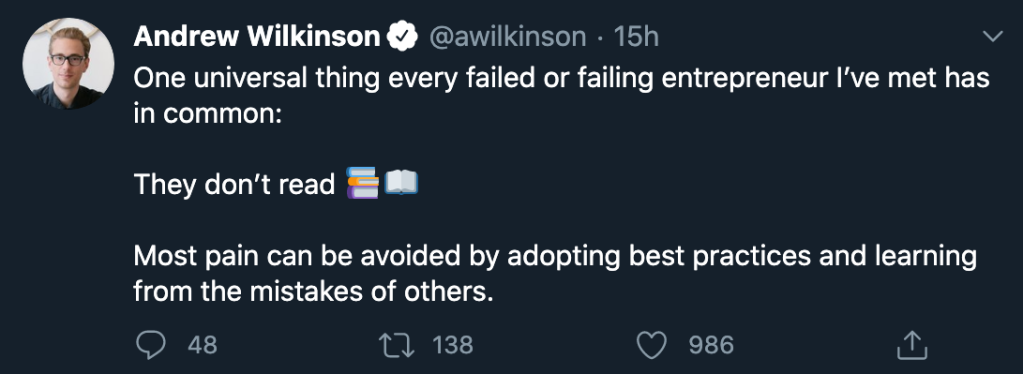This post was written by Neil Cocker, CEO of Ramp and startup validation expert on MentorCruise and first appeared on NeilCocker.com.
So, how should a startup validate whether there is a market need for what they’re creating?
There’s no one right way to answer the question - “how do I validate my startup idea”? And, even if there was perfectly, it wouldn’t guarantee success. There are too many other variables - the economy, your own health, access to finance, governments, global pandemics, and sheer luck.
But going through a thorough validation process does hugely reduce the risk of failure.
What I outline below is the method I’ve been using for a while. It’s not comprehensive, and each of the steps can be done in a much more detailed way. But it’s quick, captures good data, and gives you a very strong footing to start your journey.
Here’s how to validate your startup…
- Define your customer (1 hour)
- Write your hypothesis (1 hour)
- Create and distribute a survey (4 hours)
- Customer conversation theory (3 hours)
- Proper customer conversations (10 hours)
- Starting to sell…
Here’s a quick breakdown of each one of these.
Define your potential customer, and your potential market
You may already have a typical customer in mind, but try to drill down into something specific. It’s not enough to just say “This is for entrepreneurs”. Or “It’s for single mums”. You need to define them more clearly by their behaviours, as well as their primary characteristics. Try something like “Time-rich, cash-poor, freelancers who need extra sources of income”. Or “High net worth individuals who take more than ten flights for business a year”.
Why is this important? According to the often mis-attributed saying: “You can please some of the people all of the time, you can please all of the people some of the time, but you can’t please all of the people all of the time”. In other words, stop thinking that you can sell to everyone. Firstly, having a clear idea of who you’re potentially selling to helps you clearly visualise what they want, where they spend their time, and their money. All of which helps you better understand how your product might solve a problem for them in a way that they would be willing to pay for.
Write your hypothesis
I won’t write too much here, as there are lots of great blogposts out there that do a great job of explaining good ways of nailing this. In short, you’re looking to find a hypothesis that you can test with your customer conversations. There are several different templates for this, but this is a simple one to start with.
I believe [target market] will [engage in this behaviour / use this solution] for [this reason].
You can refine this as you go along, and as you speak to customers. After all, there’s a very good chance that your research will show you that your hypothesis is wrong.
If your hypothesis is proven wrong, you can come up with a new one, and start again.
Why is this important? Here you are looking to test your riskiest assumption first. Because if you’re wrong about this, you probably don’t have a business. Why would you want to spend several years of your life, and possibly many thousands of dollars, in order to find out that your hypothesis is wrong, when you can hugely minimise this risk by clearly defining a hypothesis, then testing it out by having conversations with potential customers. The amount of businesses I’ve mentored who didn’t properly speak to potential customers before launching is terrifying.
Customer survey
Normally surveys aren’t the best way of getting customer insight, but this is just the beginning of the conversation. It’s an easy, low-barrier, way to get people to start talking to you. Design a survey that is easy to distribute, and easy to fill in (multiple choice here). The idea is to capture some rough data that will give you some basic insights (if you’ve written some good questions). But this data alone will not give you anywhere near the insight you need. Its main function is to be the top of a funnel for getting people on the phone to do the real interviews.
Here’s an example of a real, live survey that I’m currently using to capture data from potential customers. Feel free to steal the format, and also please fill it in if you’re an early stage founder, too.
I’ve used Google Forms in this example, but I also heartily recommend the services of Doopoll.
Make it mainly multiple-choice, to make it a low barrier to people filling it in. If you feel like you want to devote one question to free-entry, then go ahead. It can sometimes be a simple “Is there anything else you would like to tell us?” thing at the end. But above all, keep it simple, and quick & easy to fill in, especially on mobile. Remember, this is about starting the conversation, not getting loads and loads of data at this point.
Distribute via the usual channels, and call in favours from people who can help you reach your target market.

Hint - Twitter is a search engine for human beings and their intentions. Want to find people interested in, for example, medtech? There’s a ton of hashtags these people will use, and that info may also be in their bio. Looking for people who are struggling to hire developers RIGHT NOW? They’ll be asking questions on Twitter (and other social media) with keywords that make them findable. It wouldn’t take too long to tweet fifty of them with a polite message, asking them to give you 2 mins of their time to fill in the survey, as they’re interested in your area of research.
Bonus - it’s also an email list for you to approach to be your beta users once you have an MVP up and running. But, be respectful. These people gave you their time for free, so don’t just add them to a never-ending drip campaign.
Customer conversations theory
I think it’s the most important business book I’ve ever read (I’m not getting paid to say that, I just genuinely believe it!), and it fundamentally changed how I talk to (potential) customers. It stopped me being obsessed with my product, and fall in love with the problem. I should get commission for how often I recommend it! If you have already read it, and are confident that you don’t need to refresh your memory, then move on to stage 3.

The Mom Test is a book that helps you speak to your customers in a way in which they can’t lie to you, subconsciously or otherwise. By talking about their life, and the problems they face around your area of interest, INSTEAD of your solution, you get an unfiltered, unbiased set of feedback about what they REALLY want to have solved. And not just feedback to the idea you have presented to them, which is probably a very different thing. This is a VERY important thing to understand, especially as “no market need” is the most often cited reason for startups failing.
Don’t let your ego get in the way of having a successful business. Your solution isn’t more important than their problem.
If you don’t want to spend 3 hours reading the book, spend an hour watching the author talk about it. If you don’t want to spend an hour watching that, spend three minutes watching this video, or reading this blogpost. Ideally you’ll do all of the above, just so you fully embrace the idea.
Speak to the ones you have chosen
Read The Mom Test before you speak to them. It’ll allow you to ask questions that get to the root of the real problems they face in this area, and not just answer questions that are limited to the scope of your proposed product. In an ideal world, they’ll end the session not having a clue what your product is. It’s all about them, NOT your product.
I’d strongly recommend speaking to at least 25 people. Preferably more like 50. If you have chosen a well-enough defined target (and not just something vague like “car owners” or “entrepreneurs”), and you listen carefully, clear trends will start to emerge. And these may well be problems that you can solve!
Hint - I strongly recommend Calendly (or similar) to provide a 15 or 20-min link to your interviewees, allowing them to book the relevant slot in your calendar. This will give them confidence that you intend to honour your 15 min promise. It also keeps you concise in your questioning, and get to the point. If they’re happy to keep talking, that’s great. But don’t abuse their goodwill.
Finally - Fall in love with the problem, not your product. The market, in a true economic sense, doesn’t care about your product. It only cares about you being able to solve a problem. Don’t succumb to Ugly Baby Syndrome, where you have come up with an idea that you LOVE, and you’re deaf to any market signals that tell you that it’s no good.
I know that I’ve made this mistake in the past. To be enthusiastic, and in love with your idea is a very normal thing. And it’s particularly typical of entrepreneurs, as we’re all out trying to change the world. But we’ve been mis-sold the concept that the moment of genius, and the idea itself, is sacrosanct. But successful entrepreneurship is about a disciplined process. And validation is an absolutely vital part of it.
I once had the “product-first instead of problem-first” way of doing things described to me as “designing a key (product) and running around trying to find a lock (problem) that it will open”. Surely it’s much better to find a lock, study it, understand it, then design a key to perfectly open it.
If you’ve done all the steps above, you now understand the lock MUCH better. Go make a key to open it.
Bonus
The great thing about this process is that it gives you a fantastic shortlist of early potential customers. But don’t think that it’s just a deceptive way of getting people on the phone so that you can sell to them. That will instantly sour their opinion of you, and mean that they will be almost impossible to convert to customers. You have to genuinely want to learn from them. That way, they will feel a part of what you are building, and they can see their input having an effect on the product.









